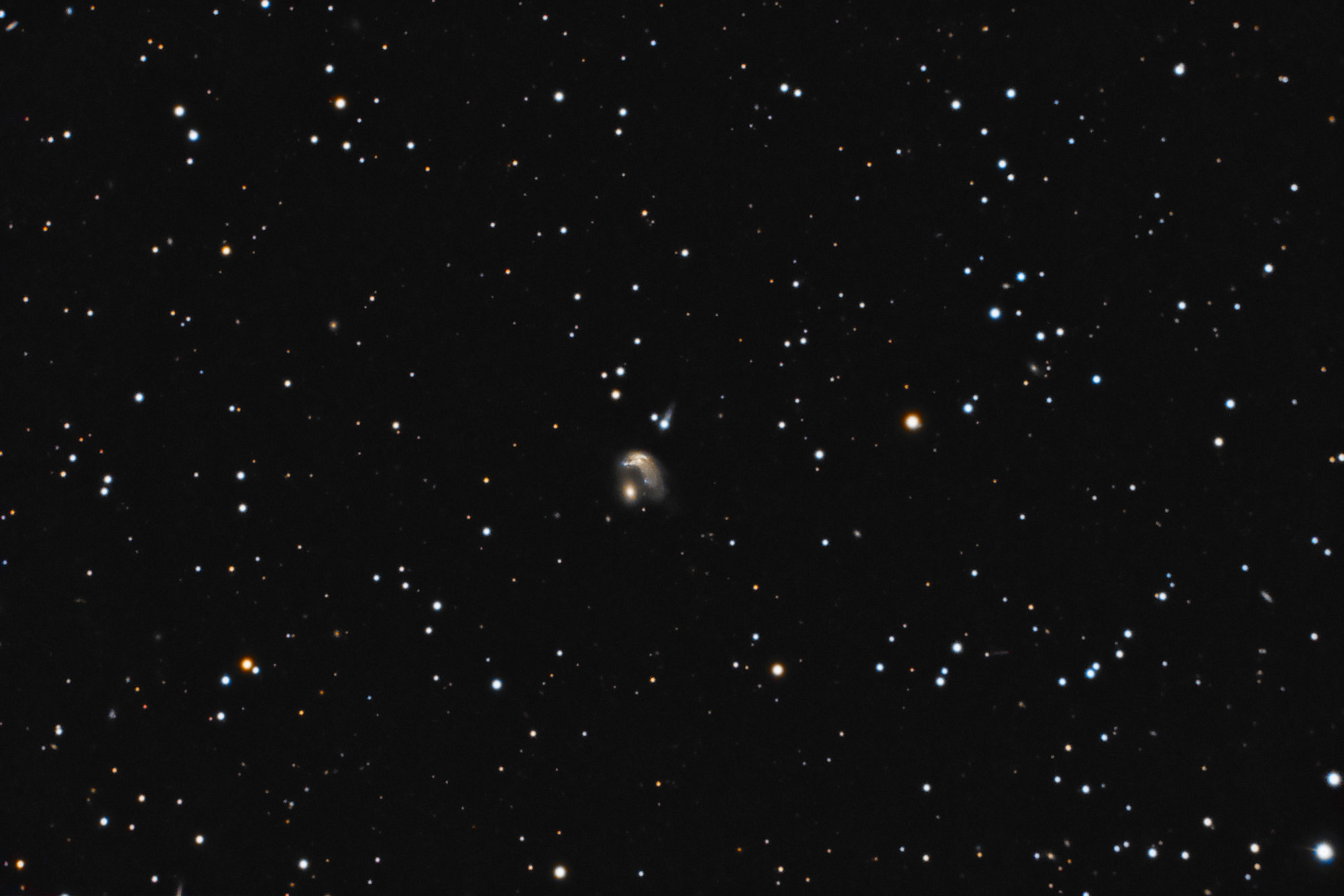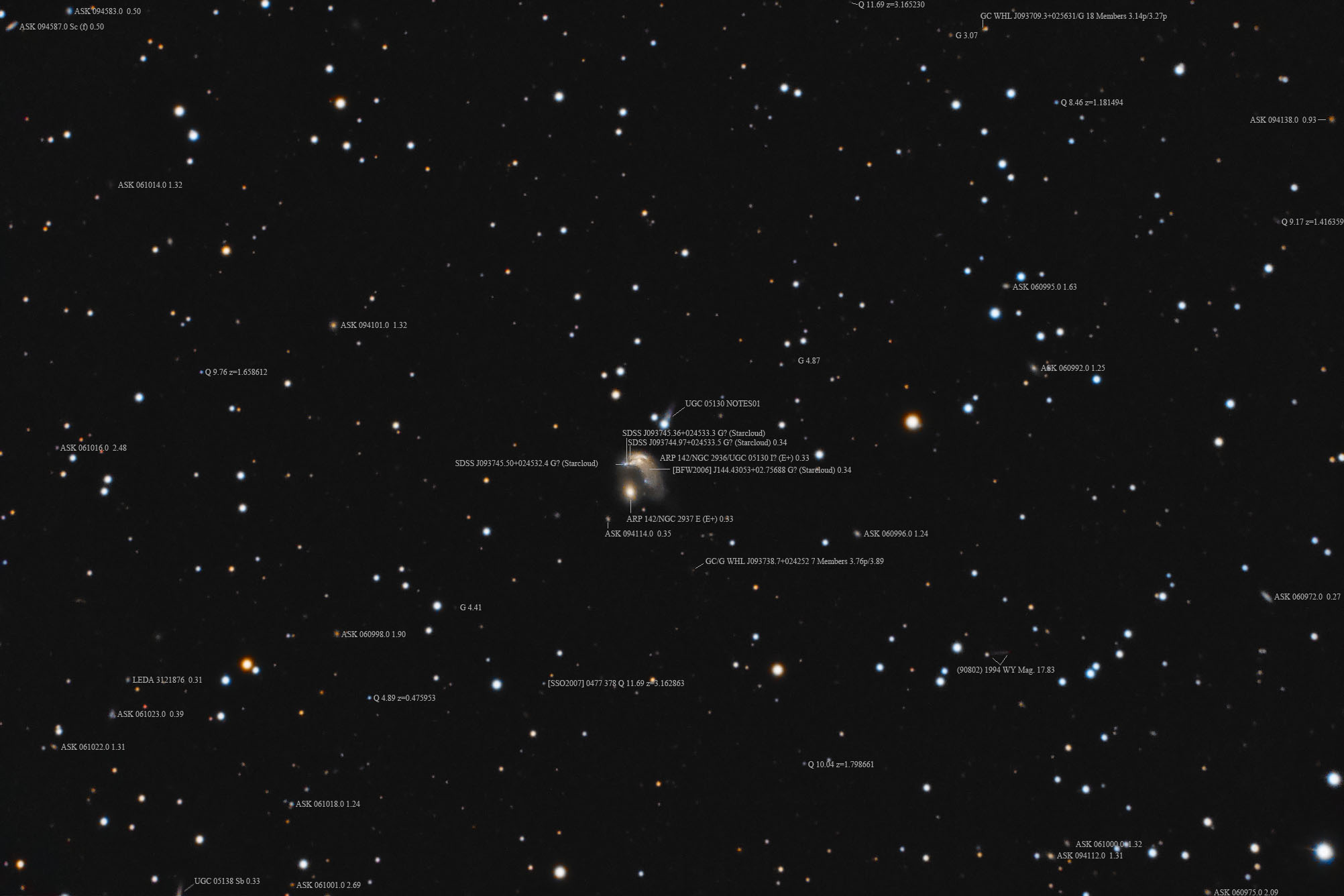| Description | Images |
Object name: ARP142Designation(s): ARP142, NGC2936, NGC2937, The Space Telescope Science Institute that runs Hubble among other things, released a Hubble image of this interacting galaxy system. That gave me the push to reprocess my image. The flats were unusable so I replaced the background with a mostly false one. Until I retake it this will have to do. It is a "tad" poorer than theirs but since my system is billions of dollars cheaper I'll live with the difference. Arp 142 consists of the two galaxies NGC 2936 and NGC 2937 which are classed as ring galaxies. They are located in Hydra near the Sextans and Leo borders and are about 330 million light-years distant. NGC 2936, the porpoise shaped galaxy, is a bit over 160,000 light-years across and is full of new, blue star clouds due to its interaction with NGC 2937. Oddly NED lists several of these as separate galaxies rather than parts of the galaxy that they really are. This is obvious from the Hubble image but might not have been prior to that. I've listed those visible in my image on the annotated image as G? (Starcloud). NED classifies NGC 2936 as I? and 2937 as E while the NGC project says E+ for both. Why NGC 2936 is highly distorted by the encounter but NGC 2937 appears unchanged I don't know. Maybe its density is so high it could hold its stars while distorting the much less dense NGC 2936. That's only a guess on my part as I found nothing to explain it. The pair was discovered by Albert Marth on March 3, 1864. Related Designation(s):2MASS J09374413+0245391, 2MASS J09374502+0244505, 2MASX J09374413+0245394, 2MASX J09374506+0244504, ARP 142, ARP 142 NED02, ARP 142 NED03, ARP 142:[MNP2009] C1, ARP 142:[MNP2009] RN, ARP 142:[RMV2008] G1, ARP142, ASK 060994.0, CGCG 035-015 NED01, CGCG 035-015 NED02, CGCG 0935.1+0258 NED01, CGCG 0935.1+0258 NED02, ECO 04865, ECO 04887, HDCE 0539 NED001, HDCE 0539 NED002, HOLM 135A, HOLM 135B, IRAS 09351+0259, IRAS F09351+0259, KPAIR J0937+0245 NED01, KPAIR J0937+0245 NED02, LDCE 0663 NED001, LDCE 0663 NED002, MCG +01-25-005, MCG +01-25-006, Mr18:[BFW2006] 03309 NED03, Mr18:[BFW2006] 03309 NED04, Mr19:[BFW2006] 06627 NED03, Mr19:[BFW2006] 06627 NED04, NGC 2936, NGC 2937, NGC2936, NGC2937, NPM1G +02.0225, NSA 012332, NSA 012333, NVSS J093744+024533, PGC 027422, PGC 027423, RESOLVE rs0100, RESOLVE rs0101, SDSS J093744.14+024538.9, SDSS J093745.02+024450.5, SDSS J093745.03+024450.4, SDSS J093745.03+024450.5, SSTSL2 J093744.17+024539.4, SSTSL2 J093745.02+024450.5, UGC 05130, UGC 05131, USGC U243 NED03, USGC U243 NED04, UZC J093744.3+024541, UZC J093745.0+024451, VV 316a, VV 316b, [BFW2006] J144.43394+02.76081 , [BFW2006] J144.43761+02.74738 , [PVK2003] J144.43303+02.76217 , [PVK2003] J144.43417+02.76083 , [PVK2003] J144.43762+02.74735 , [TTL2012] 363346, [TTL2012] 363347, | Permanent link: https://images.mantrapskies.com/catalog/ARP-GALAXIES/ARP142-NGC2936-NGC2937/ARP142NGC2936-7L4X10RGB2X10X3-R2.JPG |


